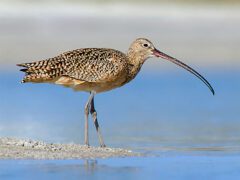Hooded Oriole Photo Gallery
Adult male
Long and slender with more delicate bodies than other orioles. Adult males vary from brilliant yellow to flame orange with a black throat that extends up around the eye. Note large white wingbar.
© Jerry Ting / Macaulay LibraryCalifornia, March 25, 2020Female
Long and slender songbird with a slightly curved bill. Females are olive-yellow overall with grayer backs and thin white wingbars. Note unstreaked grayish back.
© Vicki Miller / Macaulay LibraryCalifornia, August 04, 2017Adult male
Often forages rather sluggishly. Found in open woodlands with scattered trees, including cottonwoods, willows, sycamores, and especially palm trees.
© Larry Arbanas / Macaulay LibraryArizona, May 10, 2006Not all videos have soundImmature male
Immature males look similar to females are are olive-yellow overall, but have black throats like adult males.
© Paul Fenwick / Macaulay LibraryCalifornia, May 26, 2017Adult male
Large and slender with a long tail and sharply pointed bill. Plumage of adult males varies from yellow in northwestern Mexico and the southwestern U.S. to brilliant orange in south Texas and eastern Mexico.
© Tim Lenz / Macaulay LibraryTexas, April 20, 2013Adult male
Males in northwestern Mexico and the southwestern U.S. tend to be more yellow, while males in south Texas and eastern Mexico are more orange. Note large white wingbar.
© Steven Mlodinow / Macaulay LibraryBaja California Sur, March 17, 2010Adult male
Slender oriole with a slightly curved bill. Adult males in eastern Mexico are more orange than birds to the north.
© Fred Forssell / Macaulay LibraryArizona, April 06, 2019Female
Females are olive-yellow overall including the belly.
© Delaney Kempf / Macaulay LibraryTexas, April 16, 2019Adult male
Plumage color varies across their range from yellow-orange to bright orange.
© Tim Lenz / Macaulay LibraryArizona, April 27, 2014Immature male
Found in open woodlands with scattered trees, including cottonwoods, willows, sycamores, and especially palm trees. In areas where ornamental palms have increased, Hooded Orioles are expanding and moving farther north.
© Joshua Rudolph / Macaulay LibraryWashington, May 31, 2017Compare with Similar Species
Click on an image to compare
Species in This Family
Troupials and Allies(Order: Passeriformes, Family: Icteridae)
More to Read
Don't miss a thing! Join our email list
The Cornell Lab will send you updates about birds,
birding, and opportunities to help bird conservation.






























